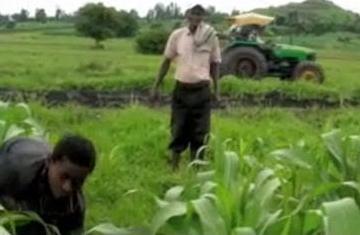
Above: Governments across Africa are leasing land to foreign
investors who use it to grow food to compensate for their own
deficit. Officials in Ethiopia hope that the investment can help
improve agriculture, replacing ox-and-plough with tractors, but
some are concerned about whether the deals benefit the lessors.
(Miguel Juarez for The Washington Post)
The ultimate crop rotation
Washington Post
By Stephanie McCrummen
Monday, November 23, 2009
BAKO, ETHIOPIA — In recent months, the Ethiopian government began marketing abroad one of the hottest commodities in an increasingly crowded and hungry world: farmland. “Why Attractive?” reads one glossy poster with photos of green fields and a map outlining swaths of the country available at bargain-basement prices. “Vast, fertile, irrigable land at low rent. Abundant water resources. Cheap labor. Warmest hospitality.” Read more.
Video: Ethiopia’s farmland in high demand (The Washington Post)


























I have driven from Awassa in the South to Gonder in the north and throughout central Ethiopia. One thing that stands out if you drive just the main highways is the fact that there is hardly an acre of idle land. It seems every square inch of flat land ans most of the hill sides are planted. Every family has to subdivide its miniture farm land to provide for its adult children. The average farmer has less than two hectares to make aliving on. Whenever I contemplate my lifetime dream of retirment on a small farm somewhere in the highlands of central Ethiopia,I always recoil because I know for me to live my dream several farm families would have to be displaced to make room for me.
Well, we now hear that only 20% of arable Ethiopian land (15 million out of a total of 74 million hectares) is presently under cultivation. I don’t know where the other 80% is. I do know that it is not anywhere in or near Bako. In fact I know it is not anywhere near or in the old provinces of Shoa, Gojam, Gonder, Arsi, Wollo or Tigrai. There might be some grazing lands that may apear uninhabited in the lowlands. But I doubt anyone is rushing to plant rice in the Ogaden or in Borena. After all, aren’t these some of the centers of the current draught and hunger? Don’t we often read of Ethiopians killing each other over meager grazing lands in the in the south-west in Gamu Gofa, Kaffa and Sidamo. I doubt these well fed foreigners would dare go to the mosquito infested western lowlands. In stead, Meles and his gand are just designating as empty the plains of Bako or Selale or Yejube or any place else they or their customers like and simply drive the inhabitants away.
That is how you creat hundreds of thousands of hectares for foreign companies in a country where the native farm families are limited to 2 hectars or less per household. All this just because some young hot heads demanded land to the tiller some 40 years ago?
Dear T. Alem,
You seem to doubt every issue the government in Ethiopia raises. This is a problem of not only you, but most Ethiopians, especially the ones in the diaspora. The question for you is: What is arable land? What is the size of Ethiopia in hectares? Is 70 million hectares a reasonable land size compared to the total? You try to make your conclusions well founded. How much of Ethiopia is constituted by the places you drove by?
I am not trying to make a reprieve. I only wish we analyze the figures without any hatred/bias. Sweeping conclusions as you have made wouldn’t make matters better.